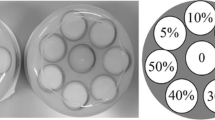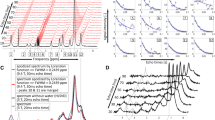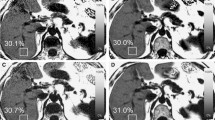Abstract
The purpose of this study was to evaluate whether disodium gadoxetate (Gd-EOB-DTPA) affects proton density fat fractions (PDFFs) during use of the multiecho Dixon (meDixon) method in phantom and simulation magnetic resonance imaging (MRI) studies at 3 T. Fat–water phantoms comprising vegetable fat–water emulsions with varying fat volume percentages (0, 5, 10, 15, 20, 30, 40, and 50) and Gd-EOB-DTPA concentrations (0 and 0.4 mM) were prepared. Phantoms without Gd-EOB-DTPA were defined as precontrast, and those with Gd-EOB-DTPA were defined as postcontrast. All phantoms were scanned with a 3 T MRI system using the meDixon method, and precontrast and postcontrast PDFFs were calculated. Simulated pre and postcontrast PDFFs in the liver were calculated using a theoretical formula. The relationship between PDFFs measured in the pre and postcontrast phantoms was evaluated using linear regression and Bland–Altman analysis. The regression analysis comparing the pre and postcontrast PDFFs yielded a slope of 0.77 (P < 0.001). The PDFFs on the postcontrast phantom were smaller than those on the precontrast phantom. The mean difference between the PDFFs on the pre and postcontrast phantoms was 6.12% (95% confidence interval 3.13 to 9.10%; limits of agreement −0.88 to 13.11%). The simulated PDFF on the postcontrast phantom was smaller than that on the precontrast phantom. We demonstrated that the PDFF measured using the meDixon was smaller on postcontrast than on precontrast at 3 T, if a low flip angle was used. This tendency was also seen in the simulation study results.



Similar content being viewed by others
Change history
14 March 2018
A diameter of glass bottles in phantoms in the above article (2 cm) was incorrect. The correct diameter is 4.5 cm.
References
Angulo P. Nonalcoholic fatty liver disease. N Engl J Med. 2002;346:1221–31.
Adams LA, Lymp JF, St Sauver J, et al. The natural history of nonalcoholic fatty liver disease: a population-based cohort study. Gastroenterology. 2005;129:113–21.
Ratziu V, Bonyhay L, Di Martino V, et al. Survival, liver failure, and hepatocellular carcinoma in obesity-related cryptogenic cirrhosis. Hepatology. 2002;35:1485–93.
Kawamura Y, Arase Y, Ikeda K, et al. Large-scale long-term follow-up study of Japanese patients with non-alcoholic fatty liver disease for the onset of hepatocellular carcinoma. Am J Gastroenterol. 2012;107:253–61.
Piccinino F, Sagenelli E, Pasquale G, Giusti G. Complications following percutaneous liver biopsy. A multicenter retrospective study on 68,276 biopsies. J Hepatol. 1986;2:165–73.
Regev A, Berho M, Jeffers LJ, et al. Sampling error and intraobserver variation in liver biopsy in patients with chronic HCV infection. Am J Gastroenterol. 2002;97:2614–8.
Hayashi T, Saitoh S, Fukuzawa K, et al. Non-invasive assessment of advanced fibrosis using hepatic volume in patients with non-alcoholic fatty liver disease. Hepatol Res. 2017;47:455–64.
Ratziu V, Charlotte F, Heurtier A, et al. Sampling variability of liver biopsy in nonalcoholic fatty liver disease. Gastroenterology. 2005;128:1898–906.
Yokoo T, Shiehmorteza M, Hamilton G, et al. Estimation of hepatic proton-density fat fraction by using MR imaging at 3.0 T. Radiology. 2011;258:749–59.
Dixon W. Simple proton spectroscopic imaging. Radiology. 1984;153:189–94.
Hines CD, Yu H, Shimakawa A, McKenzie CA, Brittain JH, Reeder SB. T1 independent, T 2* corrected MRI with accurate spectral modeling for quantification of fat: validation in a fat-water-SPIO phantom. J Magn Reson Imaging. 2009;30:1215–22.
Kukuk GM, Hittatiya K, Sprinkart AM, et al. Comparison between modified Dixon MRI techniques, MR spectroscopic relaxometry, and different histologic quantification methods in the assessment of hepatic steatosis. Eur Radiol. 2015;25:2869–79.
Yokoo T, Collins JM, Hanna RF, Bydder M, Middleton MS, Sirlin CB. Effects of intravenous gadolinium administration and flip angle on the assessment of liver fat signal fraction with opposed-phase and in-phase imaging. J Magn Reson Imaging. 2008;28:246–51.
Hernando D, Wells SA, Vigen KK, Reeder SB. Effect of hepatocyte-specific gadolinium-based contrast agents on hepatic fat-fraction and R2(*). Magn Reson Imaging. 2015;33:43–50.
de Bazelaire CM, Duhamel GD, Rofsky NM, Alsop DC. MR imaging relaxation times of abdominal and pelvic tissues measured in vivo at 3.0 T: preliminary results. Radiology. 2004;230:652–9.
Fukuzawa K, Hayashi T, Takahashi J, et al. Evaluation of six-point modified dixon and magnetic resonance spectroscopy for fat quantification: a fat-water-iron phantom study. Radiol Phys Technol. 2017;10:349–58.
Onoda M, Hyodo T, Murakami T, et al. Optimizing signal intensity correction during evaluation of hepatic parenchymal enhancement on gadoxetate disodium-enhanced MRI: comparison of three methods. Eur J Radiol. 2015;84:339–45.
Zhong X, Nickel MD, Kannengiesser SA, Dale BM, Kiefer B, Bashir MR. Liver fat quantification using a multi-step adaptive fitting approach with multi-echo GRE imaging. Magn Reson Med. 2014;72:1353–65.
Liu CY, McKenzie CA, Yu H, Brittain JH, Reeder SB. Fat quantification with IDEAL gradient echo imaging: correction of bias from T(1) and noise. Magn Reson Med. 2007;58:354–64.
Hamilton G, Middleton MS, Cunha GM, Sirlin CB. Effect of gadolinium-based contrast agent on the relaxation properties of water and fat in human liver as measured in vivo by 1H MRS. In: Book of abstracts: 21th Annual meeting of the International Society for Magnetic Resonance in Medicine; 2013. p. 1516.
Mitchell DG, Stolpen AH, Siegelman ES, Bolinger L, Outwater EK. Fatty tissue on opposed-phase MR images: paradoxical suppression of signal intensity by paramagnetic contrast agents. Radiology. 1996;198:351–7.
Acknowledgements
We thank Editage (www.editage.jp) for English language editing services. This manuscript was partly supported by Akiyoshi Ohtsuka Fellowship of the Japanese Society of Radiological Technology for improvement in English expression of a draft version of the manuscript.
Author information
Authors and Affiliations
Corresponding author
Ethics declarations
Conflict of interest
The authors declare that they have no conflicts of interest.
Research involving human participants and animals
This article does not contain any studies with human participants performed by any of the authors. This article does not contain any studies with animals performed by any of the authors.
Informed consent
Informed consent for this study was not required, because no research involving human participants was undertaken by any of the authors.
Additional information
A correction to this article is available online at https://doi.org/10.1007/s12194-018-0450-9.
About this article
Cite this article
Hayashi, T., Fukuzawa, K., Kondo, H. et al. Influence of Gd-EOB-DTPA on proton density fat fraction using the six-echo Dixon method in 3 Tesla magnetic resonance imaging. Radiol Phys Technol 10, 483–488 (2017). https://doi.org/10.1007/s12194-017-0420-7
Received:
Revised:
Accepted:
Published:
Issue Date:
DOI: https://doi.org/10.1007/s12194-017-0420-7




